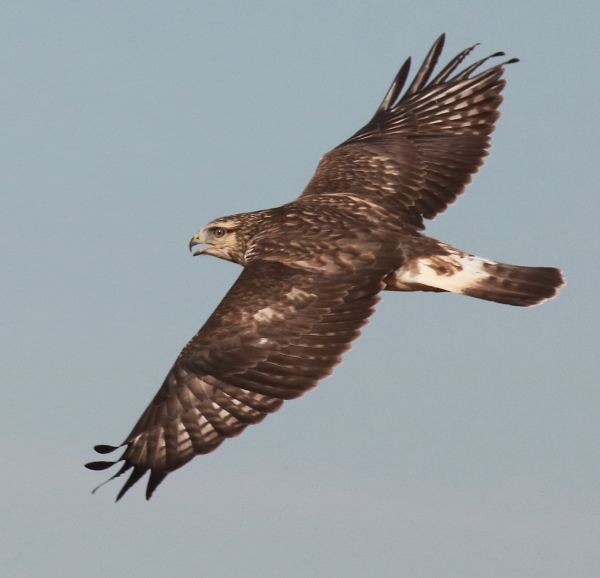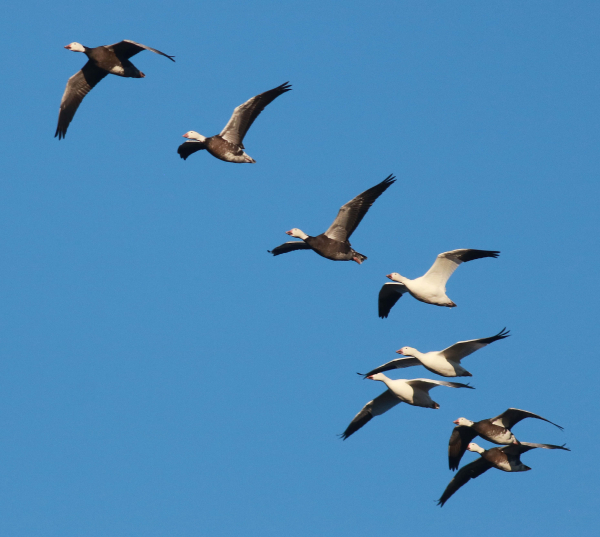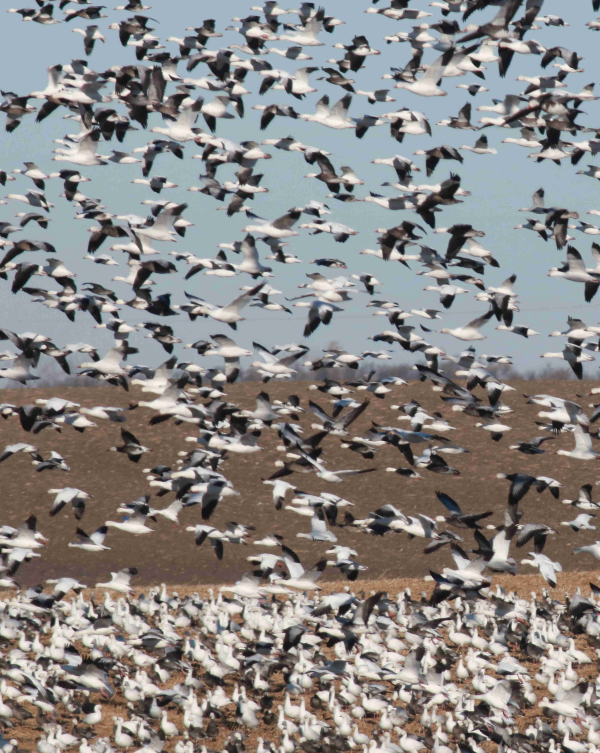
One of a series of Rough-legged Hawk photos taken last Wednesday and featured in this week’s Bird Photography feature.

Snow Geese have been the dominant birds in areas of the Northern Great Plains, including locations within a few hundred yards of Paul’s office.

|
It was fulfilling to see a Rough-legged Hawk perched on the edge of Melody’s Grove just a couple hundred yards south of home early last week, but Wednesday it became obvious there was a flight of Rough-legged Hawks across the Missouri Coteau as I observed 3 of the Arctic-nesting hawks within 4 miles of my office, and another nine before I reached the Missouri River on my way to Bismarck. But Tuesday was the real show with 5 Rough-legs hovering in hunting position on the north side of Melody’s Marsh, just south of home, and another 21 Rough-legs north along a 12-mile transect (26 Rough-legs along 13 miles).
A favored hunting location was above a hillcrest 5 miles north, where a series of Rough-legs hovered, and a black morph made a strike within a few feet of me as I stood in the open, photographing. I first spied the black morph on Tuesday, and re-sighted it in the area through Friday. My best photo opportunities took place during a brief encounter with a hunting Rough-leg that allowed me to slowly approach it as it hovered, perhaps due to a sighting of a small rodent in the prairie grass. That interaction is chronicled in this issue’s Bird Photography feature at the end of this week’s Birding Wire.
The mini-invasion of Rough-legged Hawks was exciting, but then too, it was impossible to overlook the fact that there were more than 40,000 Snow Geese just 7 miles north of my office Thursday, with at least 2 Bald Eagles watching over them. That guestimate seems high, but when I talked with my friend Ken, who farms adjacent to the deep lake where the geese were concentrating, he estimated “40 acres of geese I’d say.” We chuckled, but I didn’t doubt Ken’s unorthodox answer, which is probably as accurate as any guestimate. When you consider 1,000 per acre, which isn’t very concentrated for fall geese, my guestimate wasn’t out of line and may have been on the light side.
Even so, when the geese moved from the lake to a feeding field, they sprawled across much more landscape than 40 acres – twice that, and more. Beyond the vast numbers of Snow Geese, it was fun when I could pick out individuals and groups of smaller white Ross’s Geese hidden among the Snows. And once in a while I checked on “suspect” flocks to verify they were indeed 8 or 10 White-fronted Geese – pretty uncommon in this area during fall. Of course, there were also scattered mixed flocks of Canada and Cackling Geese, including more than one subspecies of Canadas sometimes, as evidenced by the different sizes.
More Raptors
With daily sightings of perched and migrating Bald Eagles, mostly adults, I was surprised to see a first year Bald Eagle land right next to the highway about 3 miles north of home. With a pickup driving behind me, I couldn’t pull over, thereby passing within a few feet of the alert young eagle. It flushed as the pickup advanced and I looked for a safe pull-off spot to let the truck pass. I took a U-turn and approached the eagle again, this time with the sun at my back. The mostly uniformly brown back and head of the eagle was evident as it landed in the few feet of ground between the highway and the edge of a lake. My impression was that the eagle wanted to drink, so I kept my distance to allow it to do just that.
Sure enough, it took a couple steps and bent down to drink, which I documented with a couple photos, but a passing car alerted the big raptor and it took flight again, this time winging in a half-circle that brought it much closer to me, low, until it was full-frame in my camera’s view – what luck. It’s always exciting to be that close to such a big, impressive bird making strong, deep wingbeats – WoW!
With 3 fine days of Rough-legged Hawks moving through the area, along with a scattering of Bald Eagles and even a couple Red-tailed Hawks (Friday), I wanted to share that Saturday and Sunday I observed no raptors. Seems to be a feast or famine of birds, groups of birds, or individual species – but it’s that season, and things change a couple times in a given week it seems.
More Geese
Saturday afternoon I broke away from my writing and editing to find that I was surrounded in all 4 directions by feeding flocks of geese numbering in the thousands. One huge flock was feeding about 3 miles to the north, another covered an expansive field 4 miles south. As I returned to my office, I intercepted a massive flight of geese flying from a field to the east, headed west. I followed their lead and witnessed the first geese touch down in a harvested cornfield – the first of what would become many thousands. Flock after flock circled from high to low as a tornadic swirling flock – a tornado of geese in fluid motion until culminating in a graceful landing simultaneously in numbers – all before the golden setting sun.
Monday broke all records for 2020 in the local goose universe! After seeing 3 different flocks numbering more than 10,000 that turned hillsides white with Snow [Geese], I was excited to see flocks flying low just south of home. In fact, a couple hundred Snows were assembled just beyond the edge of Melody’s Grove, less than ¼ mile south of my house, and many thousands were positioned another ¼ mile south in Melody’s Marsh and an adjoining prairie hillside. Thousands more covered many acres to the west, less than a mile from home, and there were constant flocks flying from location to location.
I pulled off the road on a low rise with the sun at my back and the marsh before me and began photographing flocks that took flight to my right and flew to my left, and oh-boy did I have fun! For about 40 minutes I enjoyed framing and photographing flocks of Snow Geese that were sprinkled with Ross’s Geese too. Part of the fun was photographing mixed flocks of Snows and Ross’s, and even more so, photographing flocks of white morph Snows with the blue color morphs mixed in. There were also many family groups among the flocks, along with obvious hybrid color morphs that mostly resembled blues, but with white bellies – that’s it, “white-bellied blues.” Rarer hybrid color morphs included mostly white geese with blue-gray back plumage. Just as rare were sightings of Cackling and Canada geese in the area, and White-fronts were nowhere in sight, but perhaps hidden among the masses.
Obvious throughout this special photo and observation episode were the incessant Arctic calls of the geese, which is the essence of late fall for me – goose music. I finally pulled myself away as the setting sun’s light dimmed, and as I walked to my front door I could hear the geese, but the sound was no longer music, it was the sound of thousands of voices as if a decisive football play was taking place in a big stadium a distance away – it was the roar of the crowd, the crowd of geese!
More Finches
Further proof of a Saturday change was an influx of finches at my feeding station, namely Pine Siskins (7 minimum at a time) and American Goldfinches (up to 6 at a time). Their activities, when added to 4 or 5 House Finches definitely made for a lively weekend outside my bay windows. The platform feeder remains a big hit with Blue Jays, and with the mix of thistle seeds among the shelled sunflower chips and seeds with mixed nuts, the finches used the platform as much as the hopper feeder.
A number of White-breasted and Red-breasted Nuthatches spice things up at the hopper feeder, and male Downy and Hairy Woodpeckers remain regulars at the no-melt suet feeder. Sunday I was glad to witness the female Hairy stopped by for an extended period during which she made repeated visits to the hopper feeder, and she fed at the platform feeder once too. It’s still interesting that she alone among the woodpeckers feeds on seeds rather than suet.
Whoopers & Varied Rare Thrush
I must report that although the 5 Whooping Cranes were still present at Sand Lake National Wildlife Refuge, last week I opted not to visit them considering that the updates I received from Barry indicated the wonderful cranes continued to behave in a similar fashion as they did during my last visit – they stay in the floodplain, often hidden behind stands of cattails, remaining white spots in the distance rather than taking flight to adjacent harvested corn fields.
Friday November 6th was the last day the 5 Whooping Cranes were still present at Sand Lake Refuge, apparently resuming their migration after a remarkable stopover that lasted at least 18 days. Many people enjoyed the opportunity to witness these rare and remarkable birds, and it would be interesting to know how they progressed on their way their wintering range along the Texas Gulf Coast, centered at Aransas National Wildlife Refuge.
As it turned out, the Whoopers weren’t the only rarities in northeast South Dakota that week. Barry also reported a male Varied Thrush that was observed in a backyard in the town of Aberdeen a couple days, but I missed that opportunity I’m afraid. I would sure like to photograph a Varied Thrush, especially a male, but next time . . . It did bring to mind the time I saw a male Varied Thrush in my backyard when I still lived in my family home in Bismarck, which was my introduction to birds traveling far off-course. When will the next one appear before me? Keep alert for rare birds, new migrants, and enjoy all the birds around you.
Article and photos by Paul Konrad
Share your bird sightings and photos at editorstbw2@gmail.com